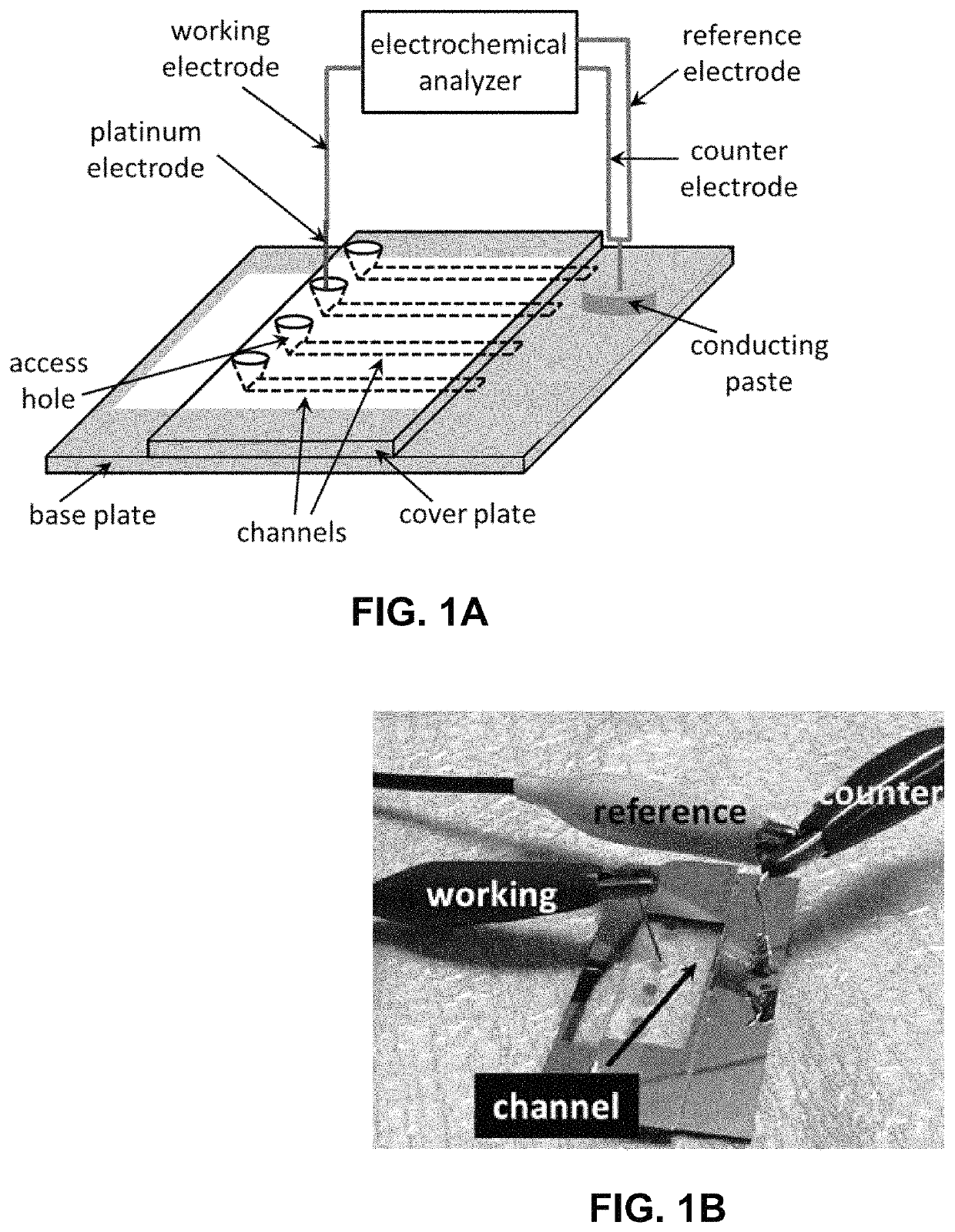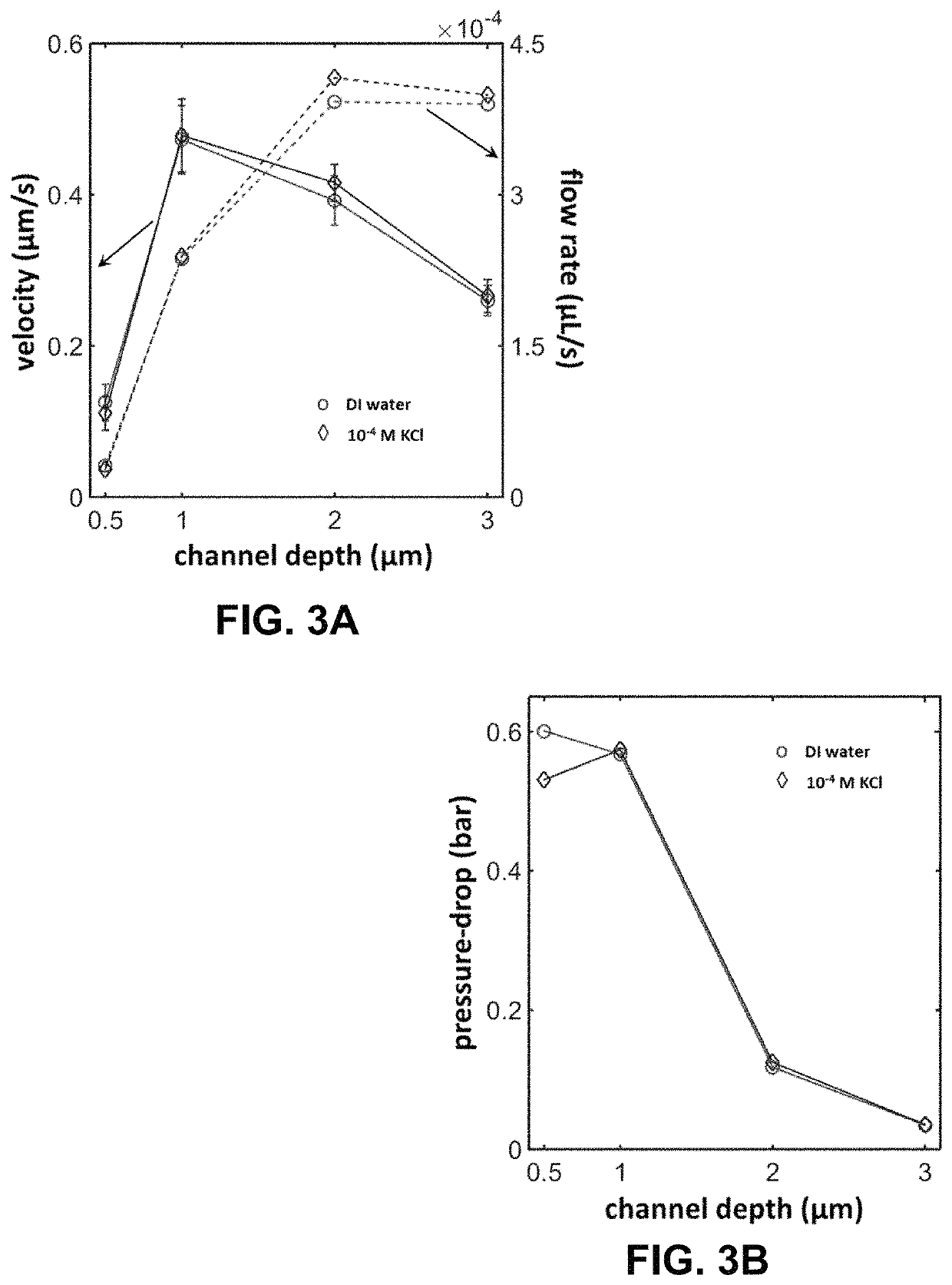Electrical energy generation in fluidic channels and membranes using spontaneous capillary flow
a fluid channel and fluid energy technology, applied in the direction of nanobatteries, cell components, sustainable manufacturing/processing, etc., can solve the problems of increasing net energy generation, decreasing etc., to increase net energy generation, reduce the complexity and size of potential fluidic batteries, and promote fluid flow
- Summary
- Abstract
- Description
- Claims
- Application Information
AI Technical Summary
Benefits of technology
Problems solved by technology
Method used
Image
Examples
example 1
l Energy Generation in a Glass Channel Using Spontaneous Capillary Flow
[0064]The use of external pumps or pressurized vessels to drive electrolytes through micro- and nano-fluidic channels presents a significant limitation in the practical use of fluidic batteries that operate based on the streaming current / potential phenomenon. The present disclosure addresses this limitation by employing spontaneous capillary flow to drive the noted transport process instead. An exemplary microfluidic electrochemical cell with an individual glass channel is fabricated to demonstrate such a battery with one of its channel terminals left open to the ambience to facilitate liquid evaporation. In this situation, a steady pressure-gradient can be produced and sustained in exemplary system through continuous vaporization of the solvent (water) at the open edge of the conduit driving the needed electrolyte flow. An electrochemical analyzer is employed to measure the electrical voltage and current produce...
example 2
l Power Generation in Micro- and Nanoscale Channels
[0107]In this example, we present example work with electrical power generation by fluidic means in micro- and nanoscale channels. The introduction of an electrolytic liquid (e.g., water) around a non-neutral solid surface leads to a distribution of electrical charges. In this situation, electrokinetic flow in the form of electro-osmosis or electrophoresis can be observed by applying a voltage across the channel terminals. Alternatively, it is possible to generate an electrical voltage across the terminals of a micro- or nanoscale channel by simply driving a fluid through it using pressure-gradient. This phenomenon occurs as the counter ions accumulated around the channel wall are transported by the pressure-driven flow causing a convection current, referred to as a streaming current. To maintain electrical neutrality at the channel terminals, a streaming potential between the two ends of the channel automatically develops yielding ...
example 3
l Energy Generation in Fluidic Channels and Membranes Using Spontaneous Capillary Flow
[0153]With the emergence of fluidic instrumentation, technologies enabling the precise transport of liquid samples through micro- and nanometer scaled structures have received significant attention from the research community. Such flows driven by electric / magnetic fields, acoustic waves, temperature gradients and surface tension among other forces have led to the development of several novel approaches to molecular separation, analyte sensing, material synthesis and energy generation methods that keep pushing scientific boundaries. One such effort focuses on the development of fluidic batteries which run by transporting electrolyte solutions around electrically charged surfaces using a pressure-drive. Electrolyte flow through a channel with a net surface charge produces an electrical current (streaming current) due to migration of the counter-ions in the Debye layer. This phenomenon causes a charg...
PUM
| Property | Measurement | Unit |
|---|---|---|
| diameter | aaaaa | aaaaa |
| length | aaaaa | aaaaa |
| length | aaaaa | aaaaa |
Abstract
Description
Claims
Application Information
 Login to View More
Login to View More - R&D
- Intellectual Property
- Life Sciences
- Materials
- Tech Scout
- Unparalleled Data Quality
- Higher Quality Content
- 60% Fewer Hallucinations
Browse by: Latest US Patents, China's latest patents, Technical Efficacy Thesaurus, Application Domain, Technology Topic, Popular Technical Reports.
© 2025 PatSnap. All rights reserved.Legal|Privacy policy|Modern Slavery Act Transparency Statement|Sitemap|About US| Contact US: help@patsnap.com



